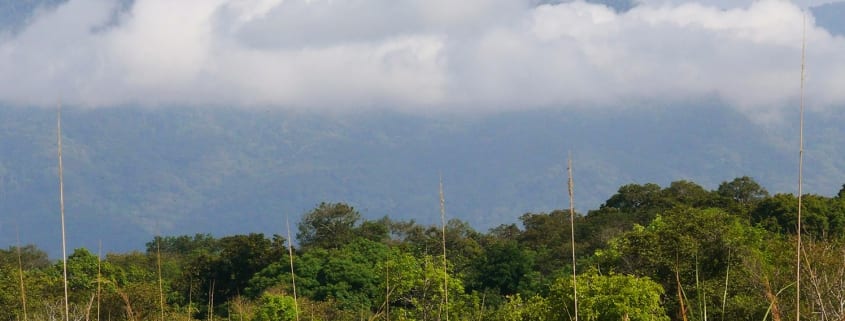Climate Change Series Part 4: The Unique, Cyclical Relationship between Climate and Tropical Forests

As previously discussed in our climate change series, there are multiple ways that tropical forests affect our global climate from carbon sequestration and deforestation emissions to cloud and precipitation formation. However, the relationship is not one-sided. Global climate, and more specifically the drastic changes we are causing, will also significantly impact our tropical forests.
Global temperatures are predicted to rise by as much as 10 degrees Fahrenheit over the next century, according to the United Nations Intergovernmental Panel on Climate Change (IPCC), and the effects on tropical forests will be tremendous. A “positive feedback loop” – referring to events or changes that further enhance more changes, pulling away from equilibrium – will most certainly be the outcome for Earth’s tropical rainforests.
This is how it works: by cutting down or burning tropical forests, the carbon stored in the plants’ mass is released into the atmosphere. The reduction in tropical plants also results in lower production of water vapor and isoprene, which means less cloud formation and precipitation. More frequent and severe droughts are likely as temperatures rise and cloud coverage and precipitation decreases. Since all plants – but tropical plants in particular – need a lot of water to survive, droughts have the potential to wipe out large swaths of rainforests. As the plants die as a result of drought, they release their stored carbon. Also, once the amount of dead and dried foliage increases, the risk of forest fires (both natural and man-made) increases. Using the increased dead plant material as fuel, the forest fire will consume even healthy plants that survived the drought. Losing tropical plants to drought and fire, combined with other sources of deforestation, brings us back to the beginning of the cycle with adding more carbon emissions to the atmosphere. And again, with more carbon in the atmosphere and fewer plants generating clouds, there will be warmer temperatures and reduced precipitation patterns. This cycle will continue to spiral out of control unless we put a stop to it.
“The relationship between deforestation and climate change is widely recognized, but the effects of climate change on forests are still being uncovered. This devastating cycle makes protecting the tropical rainforests that we still have even more urgent,”
said Rainforest Trust CEO Dr. Paul Salaman.
For example, when the Amazon River Basin suffered a “once in a century” drought in 2005, up to 5 billion tons of carbon dioxide were released into the atmosphere as a result of damage from the lack of water resources. Then in 2010, for the second time in five years, the region faced an extreme drought that should only occur once every 100 years. Together, these two droughts are responsible for releasing as much carbon dioxide as what the forest typically takes in over 10 years, according to a University of Leeds article. New research from the American Geophysical Union predicts that if deforestation rates within the entire Amazon basin remain high, the annual precipitation amount will be equal to the amount the region receives in what is now considered to be a drought year, making this the norm by 2050. Not only will this be catastrophic for the Amazon rainforest and the species and communities that depend upon it, but also for all the agricultural producers who have cut down the forest to make way for their farms. It also negatively affects communities and businesses in other parts of the world that receive precipitation created in the Amazon rainforest and transported across the globe, according to an article in The New York Times.
But, of course, it’s not that simple. Carbon dioxide is a necessary “fuel” for photosynthesis. During other historical times of elevated levels of CO2, there has been an increase in plant growth, as plants pull additional amounts of the gas out of the atmosphere. This is also happening now, according to the recent study Greening of the Earth and its drivers. The study’s authors found that global vegetation is currently experiencing a growth period, referred to as “greening,” 70 percent of which is due to increased carbon dioxide.
Unfortunately, scientists do believe that there is a threshold above which additional CO2 will not result in more robust plants, as they adjust to the rising carbon dioxide levels and growth diminishes over time. However, this remains one of the biggest causes of uncertainty in determining future climate scenarios being conducted by the IPCC, because researchers have not yet figured out when plants will reach their saturation point, according to co-author of the study and Exeter University Professor Pierre Friedlingstein.
Rainforest Trust is working diligently to mitigate the negative causes of this feedback loop by purchasing and protecting tropical lands through community engagement and local partnerships in places such as the Amazon. Through its SAVES Challenge, the conservation organization has committed to protecting 50 million acres by 2020, making a large impact on protecting our forests and the ecosystem benefits they provide all living creatures on Earth.




